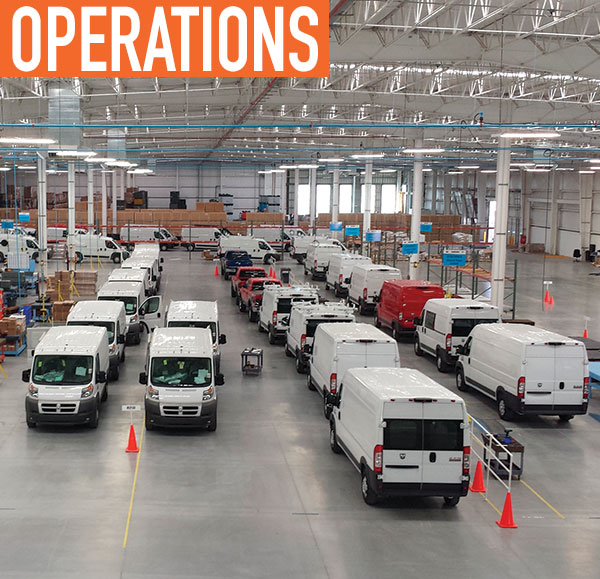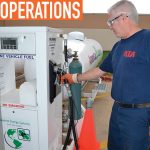There is no standard template truck or van body upfit for any given industry. Fleet upfits, in fact, need to be engineered based on a deep understanding of how each driver is using the vehicle. Knowing the industry as a whole is vital, but understanding the routines of the driver is how safety, productivity, and route efficiency is translated into bottom line savings. This focus and expertise has led many of the nation’s largest parcel, food, and utility brands to count on Utilimaster® to upfit thousands of trucks, walk-in vans, and cargo vans bodies to optimally serve the road they must travel.
Spartan Fleet Vehicles and Services, a business unit of Spartan Motors, Inc., encompasses Utilimaster and Spartan Upfit Services, which feature a variety of base models and target vehicles serving the utility, telecom, health care, construction, food and beverage, and parcel delivery markets. The company offers a combination of base packages and customized upfit services to a full range of cargo vehicle manufacturers to optimize the speed of delivery so it may efficiently and accurately serve its customers.
EXPERIENCE THE ROAD
The team at Spartan Motors hired a market research company to interview fleet managers of competitive users. What the company learned from these independent results was amazing. More than 50% of fleet managers say that, in hindsight, the selected upfit package did not fit the needs of their drivers.
Why this happens is simple: Too many sales people rush through the specification process in the interest of meeting the immediate objective of selling a truck or van upfit. Knowing the industry and a driver’s routine day is critical to support business objectives and produce an upfit that is smarter and more durable for the task at hand.
Using telematics is another great way to take advantage of the technology available to determine the needs of each customer, driver, and industry when determining the customization needed for each upfit. Telematics measure exactly where trucks are, what routes are being taken, traffic issues, speed limits, and the changing conditions a driver encounters each day.
KNOWING YOUR NEEDS
Knowing how the driver uses the vehicle throughout the day, how frequently tools are hauled in or out, and how it is being loaded is key to knowing the customization needed for each upfit. For example, in the service industry, it is essential to upfit durable vehicles to improve loading and unloading efficiencies, as drivers may be making several stops to load and unload goods and materials 25 to 50 times throughout a single day.
Fleet managers in utilities, health care, and telecommunication industries may spend more money on upfits than other industries, because they need a more customized solution. Such applications as ladder racks, storage modules, custom shelving, and partitions are common.

Simply put, the more customized a vehicle, the more benefits the applications in an upfit will have. The quality and capability of applications and components should be carefully considered at the beginning of the process. Value is more than the sum of fuel efficiency, maintenance, reliability, and capability. It goes back to needs being determined through hours of extensive research to identify measurable business outcomes.
EFFICIENCY AND PRECISION
Fleet managers are very focused on seeking ways to improve efficiency and reduce costs. A single point of release and one-time freight expense is a significant avenue to minimize steps and potential hurdles throughout the process. Having a one-stop shop to coordinate the vehicle coming in, upfit it, and then return it makes the process run smoother without adding incremental costs.
Upfitting small fleets to match the particular needs of a task at hand can pay huge dividends on an annual basis across thousands of routes for a customer. It is essential to look at total cost and value, not just low cost. Preparing for the future is smart planning for the long-term needs of a vehicle, and realizing a small customization in an upfit can create significant total value.
YOU GET WHAT YOU PAY FOR
While saving money on the initial purchase is important, the quality of applications and components should be carefully considered at the beginning of the process. The route and services provided will determine the type of applications needed and how the vehicle body should be upfitted. For example, a vehicle traveling 400 miles a day on the highway for a one-stop load and unload will be constructed differently than the same company having one vehicle drive 60 city miles with 25 stops per day to load and unload. A lighter-weight upfit construction that can handle a larger, more fragile load without increased fuel consumption would be more valuable for a 400-miles-a-day vehicle. Whereas, an alternative heavier metal with a durable construction that can handle products coming in and out many times throughout the day would be more suitable for the second scenario.

Keeping context in mind, it is important to know how long vehicles will be used for specific services. The difference of needing a series of vehicles for a two-year project commitment compared to a 12-year project commitment will play a major factor in the level of quality and necessary applications. Again, this will go back to knowing the customer and knowing how tough a driver and route are on a vehicle.
The goal of a perfect upfit build is to outlast the lifetime of the vehicle and not only do the job needed, but to do it in the most efficient, safe, and effective way possible. This can only be accomplished with a clear insight of the specific challenges faced by each driver. Knowing the needs of the industry is the foundation to being able to provide informed base packages and specialty options that enable fleet owners and operators to command their road.
ABOUT THE AUTHOR:
John Forbes is the fleet vehicles and services president at Spartan Motors. Spartan Motors, Inc. is a leading designer, engineer, manufacturer, and marketer of a broad range of specialty vehicles, specialty chassis, vehicle bodies, and parts for the fleet and delivery, recreational vehicle (RV), emergency response, defense forces, and contract assembly markets. For more, visit www.spartanmotors.com.
_______________________________________________________________________
MODERN WORKTRUCK SOLUTIONS: MAY 2017 ISSUE
Did you enjoy this article?
Subscribe to the FREE Digital Edition of Modern WorkTruck Solutions magazine.
![]()




